Rhetorical Analysis Sample Essay
Harriet Clark
Ms. Rebecca Winter
13 Feb. 2015
Not Quite a Clean Sweep: Rhetorical Strategies in
Grose's "Cleaning: The Final Feminist Frontier”
A woman’s work is never done: many American women grow up with this saying and feel it to be true. 1 One such woman, author Jessica Grose, wrote “Cleaning: The Final Feminist Frontier,” published in 2013 in the New Republic, 2 and she argues that while the men recently started taking on more of the childcare and cooking, cleaning still falls unfairly on women. 3 Grose begins building her credibility with personal facts and reputable sources, citing convincing facts and statistics, and successfully employing emotional appeals; however, toward the end of the article, her attempts to appeal to readers’ emotions weaken her credibility and ultimately, her argument. 4
In her article, Grose first sets the stage by describing a specific scenario of house-cleaning with her husband after being shut in during Hurricane Sandy, and then she outlines the uneven distribution of cleaning work in her marriage and draws a comparison to the larger feminist issue of who does the cleaning in a relationship. Grose continues by discussing some of the reasons that men do not contribute to cleaning: the praise for a clean house goes to the woman; advertising and media praise men’s cooking and childcare, but not cleaning; and lastly, it is just not fun. Possible solutions to the problem, Grose suggests, include making a chart of who does which chores, dividing up tasks based on skill and ability, accepting a dirtier home, and making cleaning more fun with gadgets. 5
Throughout her piece, Grose uses many strong sources that strengthen her credibility and appeal to ethos, as well as build her argument. 6 These sources include, “sociologists Judith Treas and Tsui-o Tai,” “a 2008 study from the University of New Hampshire,” and “P&G North America Fabric Care Brand Manager, Matthew Krehbiel” (qtd. in Grose). 7 Citing these sources boosts Grose’s credibility by showing that she has done her homework and has provided facts and statistics, as well as expert opinions to support her claim. She also uses personal examples from her own home life to introduce and support the issue, which shows that she has a personal stake in and first-hand experience with the problem. 8
Adding to her ethos appeals, Grose uses strong appeals to logos, with many facts and statistics and logical progressions of ideas. 9 She points out facts about her marriage and the distribution of household chores: “My husband and I both work. We split midnight baby feedings ...but ... he will admit that he’s never cleaned the bathroom, that I do the dishes nine times out of ten, and that he barely knows how the washer and dryer work in the apartment we’ve lived in for over eight months.” 10 These facts introduce and support the idea that Grose does more household chores than her husband. Grose continues with many statistics:
[A]bout 55 percent of American mothers employed full time do some housework on an average day, while only 18 percent of employed fathers do. ... [W]orking women with children are still doing a week and a half more of “second shift” work each year than their male partners. ... Even in the famously gender-neutral Sweden, women do 45 minutes more housework a day than their male partners. 11
These statistics are a few of many that logically support her claim that it is a substantial and real problem that men do not do their fair share of the chores. The details and numbers build an appeal to logos and impress upon the reader that this is a problem worth discussing. 12
Along with strong logos appeals, Grose effectively makes appeals to pathos in the beginning and middle sections. 13 Her introduction is full of emotionally-charged words and phrases that create a sympathetic image; Grose notes that she “was eight months pregnant” and her husband found it difficult to “fight with a massively pregnant person.” 14 The image she evokes of the challenges and vulnerabilities of being so pregnant, as well as the high emotions a woman feels at that time effectively introduce the argument and its seriousness. Her goal is to make the reader feel sympathy for her. Adding to this idea are words and phrases such as, “insisted,” “argued,” “not fun,” “sucks” “headachey,” “be judged,” “be shunned” (Grose). All of these words evoke negative emotions about cleaning, which makes the reader sympathize with women who feel “judged” and shunned”—very negative feelings. Another feeling Grose reinforces with her word choice is the concept of fairness: “fair share,” “a week and a half more of ‘second shift’ work,” “more housework,” “more gendered and less frequent.” These words help establish the unfairness that exists when women do all of the cleaning, and they are an appeal to pathos, or the readers’ feelings of frustration and anger with injustice. 15
However, the end of the article lacks the same level of effectiveness in the appeals to ethos. 16 For example, Grose notes that when men do housework, they are considered to be “’enacting “small instances of gender heroism,” or ‘SIGH’s’—which, barf.” 17 The usage of the word “barf” is jarring to the reader; unprofessional and immature, it is a shift from the researched, intelligent voice she has established and the reader is less likely to take the author seriously. This damages the strength of her credibility and her argument. 18
Additionally, her last statement in the article refers to her husband in a way that weakens the argument. 19 While returning to the introduction’s hook in the conclusion is a frequently-used strategy, Grose chooses to return to her discussion of her husband in a humorous way: Grose discusses solutions, and says there is “a huge, untapped market ... for toilet-scrubbing iPods. I bet my husband would buy one.” 20 Returning to her own marriage and husband is an appeal to ethos or personal credibility, and while that works well in the introduction, in the conclusion, it lacks the strength and seriousness that the topic deserves and was given earlier in the article. 21
Though Grose begins the essay by effectively persuading her readers of the unfair distribution of home-maintenance cleaning labor, she loses her power in the end, where she most needs to drive home her argument. Readers can see the problem exists in both her marriage and throughout the world; however, her shift to humor and sarcasm makes the reader not take the problem as seriously in the end. 22 Grose could have more seriously driven home the point that a woman’s work could be done: by a man. 23
Works Cited
Grose, Jessica. “Cleaning: The Final Feminist Frontier.” New Republic. The New Republic, 19 Mar. 2013. Web. 28 Mar. 2014.
- Article author's claim or purpose
- Summary of the article's main point in the second paragraph (could also be in the introduction)
- Third paragraph begins with a transition and topic sentence that reflects the first topic in the thesis
- Quotes illustrate how the author uses appeals to ethos
- Analysis explains how the quotes show the effective use of ethos as noted in the thesis
- Transition and topic sentence about the second point from the thesis
- Quote that illustrates appeals to logos
- Analysis explains how the quotes show the effective use of logos, as noted in the thesis
- Transition and topic sentence about the third point from the thesis
- Quotes that illustrate appeals to pathos
- Analysis explains how the quotes show the effective use of pathos, as noted in the thesis
- Transition and topic sentence about fourth point from the thesis
- Quote illustrates how the author uses appeal to ethos
- Analysis explains how quote supports thesis
- Transition and topic sentence about fourth point from thesis
- Conclusion returns to the ideas in the thesis and further develops them
- Last sentence returns to the hook in the introduction
Learn more about the " Rhetorical Analysis Graphic Organizer ."
Learn more about " Pathos, Logos, and Ethos ."
- Affiliate Program

- UNITED STATES
- 台灣 (TAIWAN)
- TÜRKIYE (TURKEY)
- Academic Editing Services
- - Research Paper
- - Journal Manuscript
- - Dissertation
- - College & University Assignments
- Admissions Editing Services
- - Application Essay
- - Personal Statement
- - Recommendation Letter
- - Cover Letter
- - CV/Resume
- Business Editing Services
- - Business Documents
- - Report & Brochure
- - Website & Blog
- Writer Editing Services
- - Script & Screenplay
- Our Editors
- Client Reviews
- Editing & Proofreading Prices
- Wordvice Points
- Partner Discount
- Plagiarism Checker
- APA Citation Generator
- MLA Citation Generator
- Chicago Citation Generator
- Vancouver Citation Generator
- - APA Style
- - MLA Style
- - Chicago Style
- - Vancouver Style
- Writing & Editing Guide
- Academic Resources
- Admissions Resources

How to Write a Rhetorical Analysis Essay–Examples & Template
What is a Rhetorical Analysis Essay?
A rhetorical analysis essay is, as the name suggests, an analysis of someone else’s writing (or speech, or advert, or even cartoon) and how they use not only words but also rhetorical techniques to influence their audience in a certain way. A rhetorical analysis is less interested in what the author is saying and more in how they present it, what effect this has on their readers, whether they achieve their goals, and what approach they use to get there.
Its structure is similar to that of most essays: An Introduction presents your thesis, a Body analyzes the text you have chosen, breaks it down into sections and explains how arguments have been constructed and how each part persuades, informs, or entertains the reader, and a Conclusion section sums up your evaluation.
Note that your personal opinion on the matter is not relevant for your analysis and that you don’t state anywhere in your essay whether you agree or disagree with the stance the author takes.
In the following, we will define the key rhetorical concepts you need to write a good rhetorical analysis and give you some practical tips on where to start.
Key Rhetorical Concepts
Your goal when writing a rhetorical analysis is to think about and then carefully describe how the author has designed their text so that it has the intended effect on their audience. To do that, you need to consider a number of key rhetorical strategies: Rhetorical appeals (“Ethos”, “Logos”, and “Pathos”), context, as well as claims, supports, and warrants.
Ethos, Logos, and Pathos were introduced by Aristotle, way back in the 4th century BC, as the main ways in which language can be used to persuade an audience. They still represent the basis of any rhetorical analysis and are often referred to as the “rhetorical triangle”.
These and other rhetorical techniques can all be combined to create the intended effect, and your job as the one analyzing a text is to break the writer’s arguments down and identify the concepts they are based on.
Rhetorical Appeals
Rhetorical appeal #1: ethos.
Ethos refers to the reputation or authority of the writer regarding the topic of their essay or speech and to how they use this to appeal to their audience. Just like we are more likely to buy a product from a brand or vendor we have confidence in than one we don’t know or have reason to distrust, Ethos-driven texts or speeches rely on the reputation of the author to persuade the reader or listener. When you analyze an essay, you should therefore look at how the writer establishes Ethos through rhetorical devices.
Does the author present themselves as an authority on their subject? If so, how?
Do they highlight how impeccable their own behavior is to make a moral argument?
Do they present themselves as an expert by listing their qualifications or experience to convince the reader of their opinion on something?
Rhetorical appeal #2: Pathos
The purpose of Pathos-driven rhetoric is to appeal to the reader’s emotions. A common example of pathos as a rhetorical means is adverts by charities that try to make you donate money to a “good cause”. To evoke the intended emotions in the reader, an author may use passionate language, tell personal stories, and employ vivid imagery so that the reader can imagine themselves in a certain situation and feel empathy with or anger towards others.
Rhetorical appeal #3: Logos
Logos, the “logical” appeal, uses reason to persuade. Reason and logic, supported by data, evidence, clearly defined methodology, and well-constructed arguments, are what most academic writing is based on. Emotions, those of the researcher/writer as well as those of the reader, should stay out of such academic texts, as should anyone’s reputation, beliefs, or personal opinions.
Text and Context
To analyze a piece of writing, a speech, an advertisement, or even a satirical drawing, you need to look beyond the piece of communication and take the context in which it was created and/or published into account.
Who is the person who wrote the text/drew the cartoon/designed the ad..? What audience are they trying to reach? Where was the piece published and what was happening there around that time?
A political speech, for example, can be powerful even when read decades later, but the historical context surrounding it is an important aspect of the effect it was intended to have.
Claims, Supports, and Warrants
To make any kind of argument, a writer needs to put forward specific claims, support them with data or evidence or even a moral or emotional appeal, and connect the dots logically so that the reader can follow along and agree with the points made.
The connections between statements, so-called “warrants”, follow logical reasoning but are not always clearly stated—the author simply assumes the reader understands the underlying logic, whether they present it “explicitly” or “implicitly”. Implicit warrants are commonly used in advertisements where seemingly happy people use certain products, wear certain clothes, accessories, or perfumes, or live certain lifestyles – with the connotation that, first, the product/perfume/lifestyle is what makes that person happy and, second, the reader wants to be as happy as the person in the ad. Some warrants are never clearly stated, and your job when writing a rhetorical analysis essay is therefore to identify them and bring them to light, to evaluate their validity, their effect on the reader, and the use of such means by the writer/creator.

What are the Five Rhetorical Situations?
A “rhetorical situation” refers to the circumstance behind a text or other piece of communication that arises from a given context. It explains why a rhetorical piece was created, what its purpose is, and how it was constructed to achieve its aims.
Rhetorical situations can be classified into the following five categories:
Asking such questions when you analyze a text will help you identify all the aspects that play a role in the effect it has on its audience, and will allow you to evaluate whether it achieved its aims or where it may have failed to do so.
Rhetorical Analysis Essay Outline
Analyzing someone else’s work can seem like a big task, but as with every assignment or writing endeavor, you can break it down into smaller, well-defined steps that give you a practical structure to follow.
To give you an example of how the different parts of your text may look when it’s finished, we will provide you with some excerpts from this rhetorical analysis essay example (which even includes helpful comments) published on the Online Writing Lab website of Excelsior University in Albany, NY. The text that this essay analyzes is this article on why one should or shouldn’t buy an Ipad. If you want more examples so that you can build your own rhetorical analysis template, have a look at this essay on Nabokov’s Lolita and the one provided here about the “Shitty First Drafts” chapter of Anne Lamott’s writing instruction book “Bird by Bird”.
Analyzing the Text
When writing a rhetorical analysis, you don’t choose the concepts or key points you think are relevant or want to address. Rather, you carefully read the text several times asking yourself questions like those listed in the last section on rhetorical situations to identify how the text “works” and how it was written to achieve that effect.
Start with focusing on the author : What do you think was their purpose for writing the text? Do they make one principal claim and then elaborate on that? Or do they discuss different topics?
Then look at what audience they are talking to: Do they want to make a group of people take some action? Vote for someone? Donate money to a good cause? Who are these people? Is the text reaching this specific audience? Why or why not?
What tone is the author using to address their audience? Are they trying to evoke sympathy? Stir up anger? Are they writing from a personal perspective? Are they painting themselves as an authority on the topic? Are they using academic or informal language?
How does the author support their claims ? What kind of evidence are they presenting? Are they providing explicit or implicit warrants? Are these warrants valid or problematic? Is the provided evidence convincing?
Asking yourself such questions will help you identify what rhetorical devices a text uses and how well they are put together to achieve a certain aim. Remember, your own opinion and whether you agree with the author are not the point of a rhetorical analysis essay – your task is simply to take the text apart and evaluate it.
If you are still confused about how to write a rhetorical analysis essay, just follow the steps outlined below to write the different parts of your rhetorical analysis: As every other essay, it consists of an Introduction , a Body (the actual analysis), and a Conclusion .
Rhetorical Analysis Introduction
The Introduction section briefly presents the topic of the essay you are analyzing, the author, their main claims, a short summary of the work by you, and your thesis statement .
Tell the reader what the text you are going to analyze represents (e.g., historically) or why it is relevant (e.g., because it has become some kind of reference for how something is done). Describe what the author claims, asserts, or implies and what techniques they use to make their argument and persuade their audience. Finish off with your thesis statement that prepares the reader for what you are going to present in the next section – do you think that the author’s assumptions/claims/arguments were presented in a logical/appealing/powerful way and reached their audience as intended?
Have a look at an excerpt from the sample essay linked above to see what a rhetorical analysis introduction can look like. See how it introduces the author and article , the context in which it originally appeared , the main claims the author makes , and how this first paragraph ends in a clear thesis statement that the essay will then elaborate on in the following Body section:
Cory Doctorow ’s article on BoingBoing is an older review of the iPad , one of Apple’s most famous products. At the time of this article, however, the iPad was simply the latest Apple product to hit the market and was not yet so popular. Doctorow’s entire career has been entrenched in and around technology. He got his start as a CD-ROM programmer and is now a successful blogger and author. He is currently the co-editor of the BoingBoing blog on which this article was posted. One of his main points in this article comes from Doctorow’s passionate advocacy of free digital media sharing. He argues that the iPad is just another way for established technology companies to control our technological freedom and creativity . In “ Why I Won’t Buy an iPad (and Think You Shouldn’t, Either) ” published on Boing Boing in April of 2010, Cory Doctorow successfully uses his experience with technology, facts about the company Apple, and appeals to consumer needs to convince potential iPad buyers that Apple and its products, specifically the iPad, limit the digital rights of those who use them by controlling and mainstreaming the content that can be used and created on the device .
Doing the Rhetorical Analysis
The main part of your analysis is the Body , where you dissect the text in detail. Explain what methods the author uses to inform, entertain, and/or persuade the audience. Use Aristotle’s rhetorical triangle and the other key concepts we introduced above. Use quotations from the essay to demonstrate what you mean. Work out why the writer used a certain approach and evaluate (and again, demonstrate using the text itself) how successful they were. Evaluate the effect of each rhetorical technique you identify on the audience and judge whether the effect is in line with the author’s intentions.
To make it easy for the reader to follow your thought process, divide this part of your essay into paragraphs that each focus on one strategy or one concept , and make sure they are all necessary and contribute to the development of your argument(s).
One paragraph of this section of your essay could, for example, look like this:
One example of Doctorow’s position is his comparison of Apple’s iStore to Wal-Mart. This is an appeal to the consumer’s logic—or an appeal to logos. Doctorow wants the reader to take his comparison and consider how an all-powerful corporation like the iStore will affect them. An iPad will only allow for apps and programs purchased through the iStore to be run on it; therefore, a customer must not only purchase an iPad but also any programs he or she wishes to use. Customers cannot create their own programs or modify the hardware in any way.
As you can see, the author of this sample essay identifies and then explains to the reader how Doctorow uses the concept of Logos to appeal to his readers – not just by pointing out that he does it but by dissecting how it is done.
Rhetorical Analysis Conclusion
The conclusion section of your analysis should restate your main arguments and emphasize once more whether you think the author achieved their goal. Note that this is not the place to introduce new information—only rely on the points you have discussed in the body of your essay. End with a statement that sums up the impact the text has on its audience and maybe society as a whole:
Overall, Doctorow makes a good argument about why there are potentially many better things to drop a great deal of money on instead of the iPad. He gives some valuable information and facts that consumers should take into consideration before going out to purchase the new device. He clearly uses rhetorical tools to help make his case, and, overall, he is effective as a writer, even if, ultimately, he was ineffective in convincing the world not to buy an iPad .
Frequently Asked Questions about Rhetorical Analysis Essays
What is a rhetorical analysis essay.
A rhetorical analysis dissects a text or another piece of communication to work out and explain how it impacts its audience, how successfully it achieves its aims, and what rhetorical devices it uses to do that.
While argumentative essays usually take a stance on a certain topic and argue for it, a rhetorical analysis identifies how someone else constructs their arguments and supports their claims.
What is the correct rhetorical analysis essay format?
Like most other essays, a rhetorical analysis contains an Introduction that presents the thesis statement, a Body that analyzes the piece of communication, explains how arguments have been constructed, and illustrates how each part persuades, informs, or entertains the reader, and a Conclusion section that summarizes the results of the analysis.
What is the “rhetorical triangle”?
The rhetorical triangle was introduced by Aristotle as the main ways in which language can be used to persuade an audience: Logos appeals to the audience’s reason, Ethos to the writer’s status or authority, and Pathos to the reader’s emotions. Logos, Ethos, and Pathos can all be combined to create the intended effect, and your job as the one analyzing a text is to break the writer’s arguments down and identify what specific concepts each is based on.
Let Wordvice help you write a flawless rhetorical analysis essay!
Whether you have to write a rhetorical analysis essay as an assignment or whether it is part of an application, our professional proofreading services feature professional editors are trained subject experts that make sure your text is in line with the required format, as well as help you improve the flow and expression of your writing. Let them be your second pair of eyes so that after receiving paper editing services or essay editing services from Wordvice, you can submit your manuscript or apply to the school of your dreams with confidence.
And check out our editing services for writers (including blog editing , script editing , and book editing ) to correct your important personal or business-related work.
- Features for Creative Writers
- Features for Work
- Features for Higher Education
- Features for Teachers
- Features for Non-Native Speakers
- Learn Blog Grammar Guide Community Events FAQ
- Grammar Guide
What Is a Rhetorical Analysis and How to Write a Great One

Helly Douglas

Do you have to write a rhetorical analysis essay? Fear not! We’re here to explain exactly what rhetorical analysis means, how you should structure your essay, and give you some essential “dos and don’ts.”
What is a Rhetorical Analysis Essay?
How do you write a rhetorical analysis, what are the three rhetorical strategies, what are the five rhetorical situations, how to plan a rhetorical analysis essay, creating a rhetorical analysis essay, examples of great rhetorical analysis essays, final thoughts.
A rhetorical analysis essay studies how writers and speakers have used words to influence their audience. Think less about the words the author has used and more about the techniques they employ, their goals, and the effect this has on the audience.
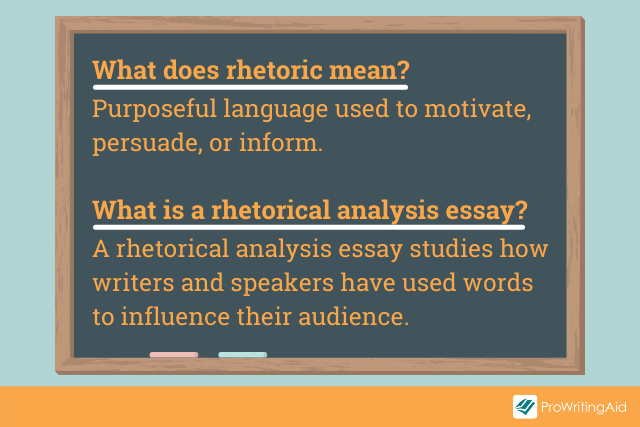
In your analysis essay, you break a piece of text (including cartoons, adverts, and speeches) into sections and explain how each part works to persuade, inform, or entertain. You’ll explore the effectiveness of the techniques used, how the argument has been constructed, and give examples from the text.
A strong rhetorical analysis evaluates a text rather than just describes the techniques used. You don’t include whether you personally agree or disagree with the argument.
Structure a rhetorical analysis in the same way as most other types of academic essays . You’ll have an introduction to present your thesis, a main body where you analyze the text, which then leads to a conclusion.
Think about how the writer (also known as a rhetor) considers the situation that frames their communication:
- Topic: the overall purpose of the rhetoric
- Audience: this includes primary, secondary, and tertiary audiences
- Purpose: there are often more than one to consider
- Context and culture: the wider situation within which the rhetoric is placed
Back in the 4th century BC, Aristotle was talking about how language can be used as a means of persuasion. He described three principal forms —Ethos, Logos, and Pathos—often referred to as the Rhetorical Triangle . These persuasive techniques are still used today.
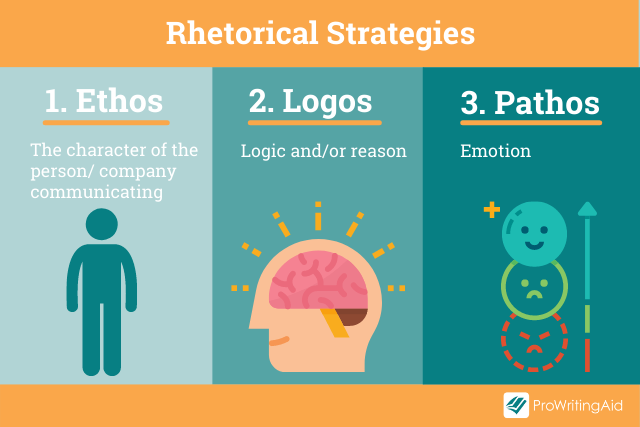
Rhetorical Strategy 1: Ethos
Are you more likely to buy a car from an established company that’s been an important part of your community for 50 years, or someone new who just started their business?
Reputation matters. Ethos explores how the character, disposition, and fundamental values of the author create appeal, along with their expertise and knowledge in the subject area.
Aristotle breaks ethos down into three further categories:
- Phronesis: skills and practical wisdom
- Arete: virtue
- Eunoia: goodwill towards the audience
Ethos-driven speeches and text rely on the reputation of the author. In your analysis, you can look at how the writer establishes ethos through both direct and indirect means.
Rhetorical Strategy 2: Pathos
Pathos-driven rhetoric hooks into our emotions. You’ll often see it used in advertisements, particularly by charities wanting you to donate money towards an appeal.
Common use of pathos includes:
- Vivid description so the reader can imagine themselves in the situation
- Personal stories to create feelings of empathy
- Emotional vocabulary that evokes a response
By using pathos to make the audience feel a particular emotion, the author can persuade them that the argument they’re making is compelling.
Rhetorical Strategy 3: Logos
Logos uses logic or reason. It’s commonly used in academic writing when arguments are created using evidence and reasoning rather than an emotional response. It’s constructed in a step-by-step approach that builds methodically to create a powerful effect upon the reader.
Rhetoric can use any one of these three techniques, but effective arguments often appeal to all three elements.
The rhetorical situation explains the circumstances behind and around a piece of rhetoric. It helps you think about why a text exists, its purpose, and how it’s carried out.
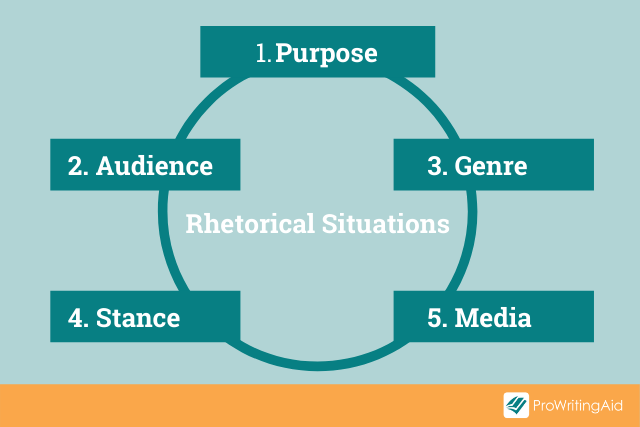
The rhetorical situations are:
- 1) Purpose: Why is this being written? (It could be trying to inform, persuade, instruct, or entertain.)
- 2) Audience: Which groups or individuals will read and take action (or have done so in the past)?
- 3) Genre: What type of writing is this?
- 4) Stance: What is the tone of the text? What position are they taking?
- 5) Media/Visuals: What means of communication are used?
Understanding and analyzing the rhetorical situation is essential for building a strong essay. Also think about any rhetoric restraints on the text, such as beliefs, attitudes, and traditions that could affect the author's decisions.
Before leaping into your essay, it’s worth taking time to explore the text at a deeper level and considering the rhetorical situations we looked at before. Throw away your assumptions and use these simple questions to help you unpick how and why the text is having an effect on the audience.

1: What is the Rhetorical Situation?
- Why is there a need or opportunity for persuasion?
- How do words and references help you identify the time and location?
- What are the rhetoric restraints?
- What historical occasions would lead to this text being created?
2: Who is the Author?
- How do they position themselves as an expert worth listening to?
- What is their ethos?
- Do they have a reputation that gives them authority?
- What is their intention?
- What values or customs do they have?
3: Who is it Written For?
- Who is the intended audience?
- How is this appealing to this particular audience?
- Who are the possible secondary and tertiary audiences?
4: What is the Central Idea?
- Can you summarize the key point of this rhetoric?
- What arguments are used?
- How has it developed a line of reasoning?
5: How is it Structured?
- What structure is used?
- How is the content arranged within the structure?
6: What Form is Used?
- Does this follow a specific literary genre?
- What type of style and tone is used, and why is this?
- Does the form used complement the content?
- What effect could this form have on the audience?
7: Is the Rhetoric Effective?
- Does the content fulfil the author’s intentions?
- Does the message effectively fit the audience, location, and time period?
Once you’ve fully explored the text, you’ll have a better understanding of the impact it’s having on the audience and feel more confident about writing your essay outline.
A great essay starts with an interesting topic. Choose carefully so you’re personally invested in the subject and familiar with it rather than just following trending topics. There are lots of great ideas on this blog post by My Perfect Words if you need some inspiration. Take some time to do background research to ensure your topic offers good analysis opportunities.
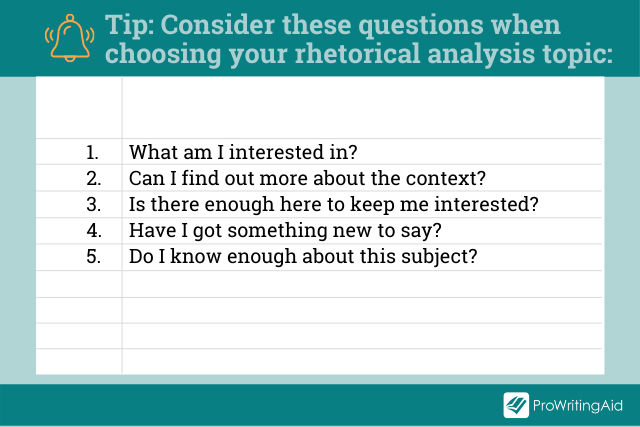
Remember to check the information given to you by your professor so you follow their preferred style guidelines. This outline example gives you a general idea of a format to follow, but there will likely be specific requests about layout and content in your course handbook. It’s always worth asking your institution if you’re unsure.
Make notes for each section of your essay before you write. This makes it easy for you to write a well-structured text that flows naturally to a conclusion. You will develop each note into a paragraph. Look at this example by College Essay for useful ideas about the structure.
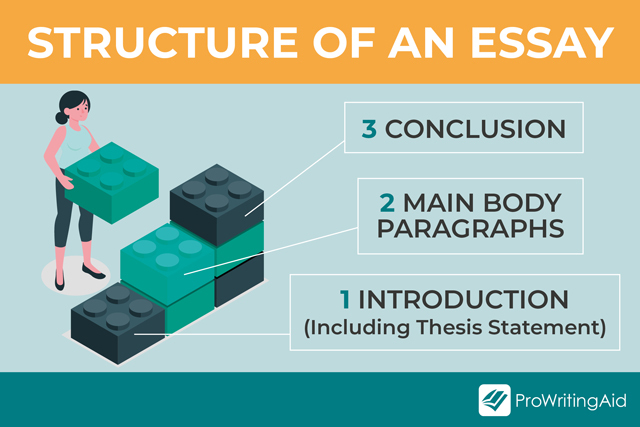
1: Introduction
This is a short, informative section that shows you understand the purpose of the text. It tempts the reader to find out more by mentioning what will come in the main body of your essay.
- Name the author of the text and the title of their work followed by the date in parentheses
- Use a verb to describe what the author does, e.g. “implies,” “asserts,” or “claims”
- Briefly summarize the text in your own words
- Mention the persuasive techniques used by the rhetor and its effect
Create a thesis statement to come at the end of your introduction.
After your introduction, move on to your critical analysis. This is the principal part of your essay.
- Explain the methods used by the author to inform, entertain, and/or persuade the audience using Aristotle's rhetorical triangle
- Use quotations to prove the statements you make
- Explain why the writer used this approach and how successful it is
- Consider how it makes the audience feel and react
Make each strategy a new paragraph rather than cramming them together, and always use proper citations. Check back to your course handbook if you’re unsure which citation style is preferred.
3: Conclusion
Your conclusion should summarize the points you’ve made in the main body of your essay. While you will draw the points together, this is not the place to introduce new information you’ve not previously mentioned.
Use your last sentence to share a powerful concluding statement that talks about the impact the text has on the audience(s) and wider society. How have its strategies helped to shape history?
Before You Submit
Poor spelling and grammatical errors ruin a great essay. Use ProWritingAid to check through your finished essay before you submit. It will pick up all the minor errors you’ve missed and help you give your essay a final polish. Look at this useful ProWritingAid webinar for further ideas to help you significantly improve your essays. Sign up for a free trial today and start editing your essays!
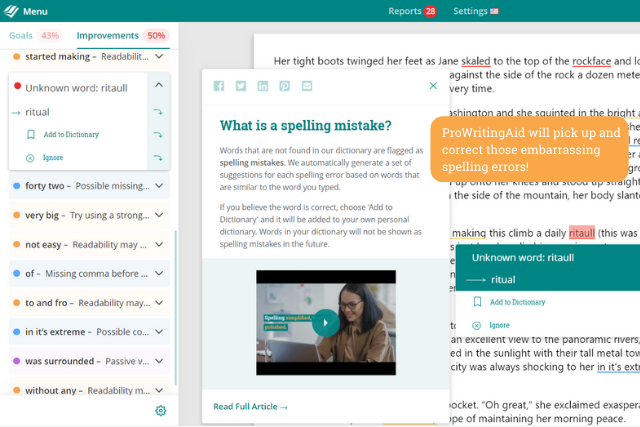
You’ll find countless examples of rhetorical analysis online, but they range widely in quality. Your institution may have example essays they can share with you to show you exactly what they’re looking for.
The following links should give you a good starting point if you’re looking for ideas:
Pearson Canada has a range of good examples. Look at how embedded quotations are used to prove the points being made. The end questions help you unpick how successful each essay is.
Excelsior College has an excellent sample essay complete with useful comments highlighting the techniques used.
Brighton Online has a selection of interesting essays to look at. In this specific example, consider how wider reading has deepened the exploration of the text.
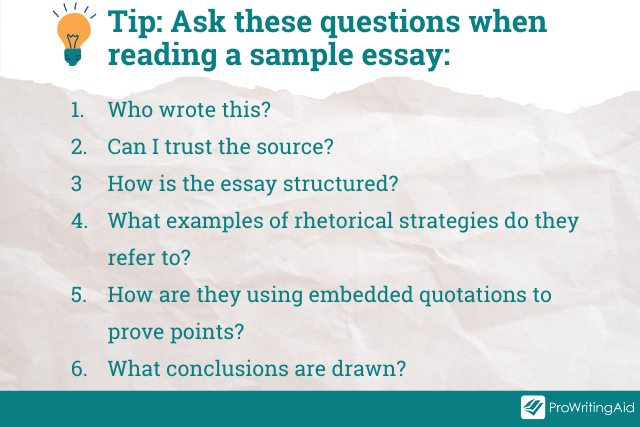
Writing a rhetorical analysis essay can seem daunting, but spending significant time deeply analyzing the text before you write will make it far more achievable and result in a better-quality essay overall.
It can take some time to write a good essay. Aim to complete it well before the deadline so you don’t feel rushed. Use ProWritingAid’s comprehensive checks to find any errors and make changes to improve readability. Then you’ll be ready to submit your finished essay, knowing it’s as good as you can possibly make it.

Try ProWritingAid's Editor for Yourself

Be confident about grammar
Check every email, essay, or story for grammar mistakes. Fix them before you press send.
Helly Douglas is a UK writer and teacher, specialising in education, children, and parenting. She loves making the complex seem simple through blogs, articles, and curriculum content. You can check out her work at hellydouglas.com or connect on Twitter @hellydouglas. When she’s not writing, you will find her in a classroom, being a mum or battling against the wilderness of her garden—the garden is winning!
Get started with ProWritingAid
Drop us a line or let's stay in touch via :
Are you seeking one-on-one college counseling and/or essay support? Limited spots are now available. Click here to learn more.
How to Write the AP Lang Rhetorical Analysis Essay (With Example)
November 27, 2023
Feeling intimidated by the AP Lang Rhetorical Analysis Essay? We’re here to help demystify. Whether you’re cramming for the AP Lang exam right now or planning to take the test down the road, we’ve got crucial rubric information, helpful tips, and an essay example to prepare you for the big day. This post will cover 1) What is the AP Lang Rhetorical Analysis Essay? 2) AP Lang Rhetorical Analysis Rubric 3) AP Lang Rhetorical Analysis: Sample Prompt 4) AP Lang Rhetorical Analysis Essay Example 5)AP Lang Rhetorical Analysis Essay Example: Why It Works
What is the AP Lang Rhetorical Analysis Essay?
The AP Lang Rhetorical Analysis Essay is one of three essays included in the written portion of the AP English Exam. The full AP English Exam is 3 hours and 15 minutes long, with the first 60 minutes dedicated to multiple-choice questions. Once you complete the multiple-choice section, you move on to three equally weighted essays that ask you to synthesize, analyze, and interpret texts and develop well-reasoned arguments. The three essays include:
Synthesis essay: You’ll review various pieces of evidence and then write an essay that synthesizes (aka combines and interprets) the evidence and presents a clear argument. Read our write up on How to Write the AP Lang Synthesis Essay here.
Argumentative essay: You’ll take a stance on a specific topic and argue your case.
Rhetorical essay: You’ll read a provided passage, then analyze the author’s rhetorical choices and develop an argument that explains why the author made those rhetorical choices.
AP Lang Rhetorical Analysis Rubric
The AP Lang Rhetorical Analysis Essay is graded on just 3 rubric categories: Thesis, Evidence and Commentary, and Sophistication . At a glance, the rubric categories may seem vague, but AP exam graders are actually looking for very particular things in each category. We’ll break it down with dos and don’ts for each rubric category:
Thesis (0-1 point)
There’s nothing nebulous when it comes to grading AP Lang Rhetorical Analysis Essay thesis. You either have one or you don’t. Including a thesis gets you one point closer to a high score and leaving it out means you miss out on one crucial point. So, what makes a thesis that counts?
- Make sure your thesis argues something about the author’s rhetorical choices. Making an argument means taking a risk and offering your own interpretation of the provided text. This is an argument that someone else might disagree with.
- A good test to see if you have a thesis that makes an argument. In your head, add the phrase “I think that…” to the beginning of your thesis. If what follows doesn’t logically flow after that phrase (aka if what follows isn’t something you and only you think), it’s likely you’re not making an argument.
- Avoid a thesis that merely restates the prompt.
- Avoid a thesis that summarizes the text but does not make an argument.
Evidence and Commentary (0-4 points)
This rubric category is graded on a scale of 0-4 where 4 is the highest grade. Per the AP Lang Rhetorical Analysis rubric, to get a 4, you’ll want to:
- Include lots of specific evidence from the text. There is no set golden number of quotes to include, but you’ll want to make sure you’re incorporating more than a couple pieces of evidence that support your argument about the author’s rhetorical choices.
- Make sure you include more than one type of evidence, too. Let’s say you’re working on your essay and have gathered examples of alliteration to include as supporting evidence. That’s just one type of rhetorical choice, and it’s hard to make a credible argument if you’re only looking at one type of evidence. To fix that issue, reread the text again looking for patterns in word choice and syntax, meaningful figurative language and imagery, literary devices, and other rhetorical choices, looking for additional types of evidence to support your argument.
- After you include evidence, offer your own interpretation and explain how this evidence proves the point you make in your thesis.
- Don’t summarize or speak generally about the author and the text. Everything you write must be backed up with evidence.
- Don’t let quotes speak for themselves. After every piece of evidence you include, make sure to explain your interpretation. Also, connect the evidence to your overarching argument.
Sophistication (0-1 point)
In this case, sophistication isn’t about how many fancy vocabulary words or how many semicolons you use. According to College Board , one point can be awarded to AP Lang Rhetorical Analysis essays that “demonstrate sophistication of thought and/or a complex understanding of the rhetorical situation” in any of these three ways:
- Explaining the significance or relevance of the writer’s rhetorical choices.
- Explaining the purpose or function of the passage’s complexities or tensions.
- Employing a style that is consistently vivid and persuasive.
Note that you don’t have to achieve all three to earn your sophistication point. A good way to think of this rubric category is to consider it a bonus point that you can earn for going above and beyond in depth of analysis or by writing an especially persuasive, clear, and well-structured essay. In order to earn this point, you’ll need to first do a good job with your thesis, evidence, and commentary.
- Focus on nailing an argumentative thesis and multiple types of evidence. Getting these fundamentals of your essay right will set you up for achieving depth of analysis.
- Explain how each piece of evidence connects to your thesis.
- Spend a minute outlining your essay before you begin to ensure your essay flows in a clear and cohesive way.
- Steer clear of generalizations about the author or text.
- Don’t include arguments you can’t prove with evidence from the text.
- Avoid complex sentences and fancy vocabulary words unless you use them often. Long, clunky sentences with imprecisely used words are hard to follow.
AP Lang Rhetorical Analysis: Sample Prompt
The sample prompt below is published online by College Board and is a real example from the 2021 AP Exam. The prompt provides background context, essay instructions, and the text you need to analyze. For sake of space, we’ve included the text as an image you can click to read. After the prompt, we provide a sample high scoring essay and then explain why this AP Lang Rhetorical Analysis essay example works.
Suggested time—40 minutes.
(This question counts as one-third of the total essay section score.)
On February 27, 2013, while in office, former president Barack Obama delivered the following address dedicating the Rosa Parks statue in the National Statuary Hall of the United States Capitol building. Rosa Parks was an African American civil rights activist who was arrested in 1955 for refusing to give up her seat on a segregated bus in Montgomery, Alabama. Read the passage carefully. Write an essay that analyzes the rhetorical choices Obama makes to convey his message.
In your response you should do the following:
- Respond to the prompt with a thesis that analyzes the writer’s rhetorical choices.
- Select and use evidence to support your line of reasoning.
- Explain how the evidence supports your line of reasoning.
- Demonstrate an understanding of the rhetorical situation.
- Use appropriate grammar and punctuation in communicating your argument.
AP Lang Rhetorical Analysis Essay Example
In his speech delivered in 2013 at the dedication of Rosa Park’s statue, President Barack Obama acknowledges everything that Parks’ activism made possible in the United States. Telling the story of Parks’ life and achievements, Obama highlights the fact that Parks was a regular person whose actions accomplished enormous change during the civil rights era. Through the use of diction that portrays Parks as quiet and demure, long lists that emphasize the extent of her impacts, and Biblical references, Obama suggests that all of us are capable of achieving greater good, just as Parks did.
Although it might be a surprising way to start to his dedication, Obama begins his speech by telling us who Parks was not: “Rosa Parks held no elected office. She possessed no fortune” he explains in lines 1-2. Later, when he tells the story of the bus driver who threatened to have Parks arrested when she refused to get off the bus, he explains that Parks “simply replied, ‘You may do that’” (lines 22-23). Right away, he establishes that Parks was a regular person who did not hold a seat of power. Her protest on the bus was not part of a larger plan, it was a simple response. By emphasizing that Parks was not powerful, wealthy, or loud spoken, he implies that Parks’ style of activism is an everyday practice that all of us can aspire to.
AP Lang Rhetorical Analysis Essay Example (Continued)
Even though Obama portrays Parks as a demure person whose protest came “simply” and naturally, he shows the importance of her activism through long lists of ripple effects. When Parks challenged her arrest, Obama explains, Martin Luther King, Jr. stood with her and “so did thousands of Montgomery, Alabama commuters” (lines 27-28). They began a boycott that included “teachers and laborers, clergy and domestics, through rain and cold and sweltering heat, day after day, week after week, month after month, walking miles if they had to…” (lines 28-31). In this section of the speech, Obama’s sentences grow longer and he uses lists to show that Parks’ small action impacted and inspired many others to fight for change. Further, listing out how many days, weeks, and months the boycott lasted shows how Parks’ single act of protest sparked a much longer push for change.
To further illustrate Parks’ impact, Obama incorporates Biblical references that emphasize the importance of “that single moment on the bus” (lines 57-58). In lines 33-35, Obama explains that Parks and the other protestors are “driven by a solemn determination to affirm their God-given dignity” and he also compares their victory to the fall the “ancient walls of Jericho” (line 43). By of including these Biblical references, Obama suggests that Parks’ action on the bus did more than correct personal or political wrongs; it also corrected moral and spiritual wrongs. Although Parks had no political power or fortune, she was able to restore a moral balance in our world.
Toward the end of the speech, Obama states that change happens “not mainly through the exploits of the famous and the powerful, but through the countless acts of often anonymous courage and kindness” (lines 78-81). Through carefully chosen diction that portrays her as a quiet, regular person and through lists and Biblical references that highlight the huge impacts of her action, Obama illustrates exactly this point. He wants us to see that, just like Parks, the small and meek can change the world for the better.
AP Lang Rhetorical Analysis Essay Example: Why It Works
We would give the AP Lang Rhetorical Analysis essay above a score of 6 out of 6 because it fully satisfies the essay’s 3 rubric categories: Thesis, Evidence and Commentary, and Sophistication . Let’s break down what this student did:
The thesis of this essay appears in the last line of the first paragraph:
“ Through the use of diction that portrays Parks as quiet and demure, long lists that emphasize the extent of her impacts, and Biblical references, Obama suggests that all of us are capable of achieving greater good, just as Parks did .”
This student’s thesis works because they make a clear argument about Obama’s rhetorical choices. They 1) list the rhetorical choices that will be analyzed in the rest of the essay (the italicized text above) and 2) include an argument someone else might disagree with (the bolded text above).
Evidence and Commentary:
This student includes substantial evidence and commentary. Things they do right, per the AP Lang Rhetorical Analysis rubric:
- They include lots of specific evidence from the text in the form of quotes.
- They incorporate 3 different types of evidence (diction, long lists, Biblical references).
- After including evidence, they offer an interpretation of what the evidence means and explain how the evidence contributes to their overarching argument (aka their thesis).
Sophistication
This essay achieves sophistication according to the AP Lang Rhetorical Analysis essay rubric in a few key ways:
- This student provides an introduction that flows naturally into the topic their essay will discuss. Before they get to their thesis, they tell us that Obama portrays Parks as a “regular person” setting up their main argument: Obama wants all regular people to aspire to do good in the world just as Rosa Parks did.
- They organize evidence and commentary in a clear and cohesive way. Each body paragraph focuses on just one type of evidence.
- They explain how their evidence is significant. In the final sentence of each body paragraph, they draw a connection back to the overarching argument presented in the thesis.
- All their evidence supports the argument presented in their thesis. There is no extraneous evidence or misleading detail.
- They consider nuances in the text. Rather than taking the text at face value, they consider what Obama’s rhetorical choices imply and offer their own unique interpretation of those implications.
- In their final paragraph, they come full circle, reiterate their thesis, and explain what Obama’s rhetorical choices communicate to readers.
- Their sentences are clear and easy to read. There are no grammar errors or misused words.
AP Lang Rhetorical Analysis Essay—More Resources
Looking for more tips to help your master your AP Lang Rhetorical Analysis Essay? Brush up on 20 Rhetorical Devices High School Students Should Know and read our Tips for Improving Reading Comprehension . If you’re ready to start studying for another part of the AP English Exam, find more expert tips in our How to Write the AP Lang Synthesis blog post.
Considering what other AP classes to take? Read up on the Hardest AP Classes .
- High School Success
Christina Wood
Christina Wood holds a BA in Literature & Writing from UC San Diego, an MFA in Creative Writing from Washington University in St. Louis, and is currently a Doctoral Candidate in English at the University of Georgia, where she teaches creative writing and first-year composition courses. Christina has published fiction and nonfiction in numerous publications, including The Paris Review , McSweeney’s , Granta , Virginia Quarterly Review , The Sewanee Review , Mississippi Review , and Puerto del Sol , among others. Her story “The Astronaut” won the 2018 Shirley Jackson Award for short fiction and received a “Distinguished Stories” mention in the 2019 Best American Short Stories anthology.
- 2-Year Colleges
- Application Strategies
- Best Colleges by Major
- Best Colleges by State
- Big Picture
- Career & Personality Assessment
- College Essay
- College Search/Knowledge
- College Success
- Costs & Financial Aid
- Data Visualizations
- Dental School Admissions
- Extracurricular Activities
- Graduate School Admissions
- High Schools
- Law School Admissions
- Medical School Admissions
- Navigating the Admissions Process
- Online Learning
- Private High School Spotlight
- Summer Program Spotlight
- Summer Programs
- Teacher Tools
- Test Prep Provider Spotlight
“Innovative and invaluable…use this book as your college lifeline.”
— Lynn O'Shaughnessy
Nationally Recognized College Expert
College Planning in Your Inbox
Join our information-packed monthly newsletter.
Rhetorical Analysis Essay
Rhetorical Analysis Essay Example
Rhetorical Analysis Essay Example - Free Samples
11 min read
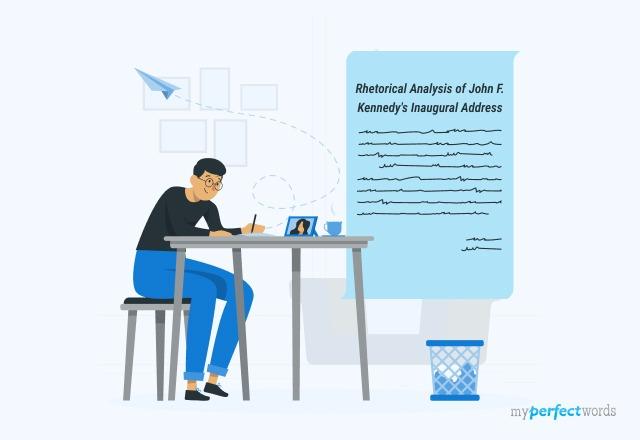
People also read
Rhetorical Analysis Essay - A Complete Guide With Examples
Rhetorical Analysis Essay Topics – 120+ Unique Ideas
Crafting an Effective Rhetorical Analysis Essay Outline - Free Samples!
Ethos, Pathos, and Logos - Structure, Usage & Examples
Writing a rhetorical analysis essay for academics can be really demanding for students. This type of paper requires high-level analyzing abilities and professional writing skills to be drafted effectively.
As this essay persuades the audience, it is essential to know how to take a strong stance and develop a thesis.
This article will find some examples that will help you with your rhetorical analysis essay writing effortlessly.
- 1. Good Rhetorical Analysis Essay Example
- 2. Rhetorical Analysis Essay Example AP Lang 2023
- 3. Rhetorical Analysis Essay Examples for Students
- 4. Writing a Visual Rhetorical Analysis Essay with Example
- 5. Rhetorical Analysis Essay Writing Tips
Good Rhetorical Analysis Essay Example
The step-by-step writing process of a rhetorical analysis essay is far more complicated than ordinary academic essays. This essay type critically analyzes the rhetorical means used to persuade the audience and their efficiency.
The example provided below is the best rhetorical analysis essay example:
Rhetorical Analysis Essay Sample
In this essay type, the author uses rhetorical approaches such as ethos, pathos, and logos . These approaches are then studied and analyzed deeply by the essay writers to weigh their effectiveness in delivering the message.
Let’s take a look at the following example to get a better idea;
The outline and structure of a rhetorical analysis essay are important.
According to the essay outline, the essay is divided into three sections:
- Introduction
- Ethos
- Logos
A rhetorical analysis essay outline is the same as the traditional one. The different parts of the rhetorical analysis essay are written in the following way:
Rhetorical Analysis Introduction Example
The introductory paragraph of a rhetorical analysis essay is written for the following purpose:
- To provide basic background information about the chosen author and the text.
- Identify the target audience of the essay.
An introduction for a rhetorical essay is drafted by:
- Stating an opening sentence known as the hook statement. This catchy sentence is prepared to grab the audience’s attention to the paper.
- After the opening sentence, the background information of the author and the original text are provided.
For example, a rhetorical analysis essay written by Lee Jennings on“The Right Stuff” by David Suzuki. Lee started the essay by providing the introduction in the following way:
Analysis of the Example:
- Suzuki stresses the importance of high school education. He prepares his readers for a proposal to make that education as valuable as possible.
- A rhetorical analysis can show how successful Suzuki was in using logos, pathos, and ethos. He had a strong ethos because of his reputation.
- He also used pathos to appeal to parents and educators. However, his use of logos could have been more successful.
- Here Jennings stated the background information about the text and highlighted the rhetorical techniques used and their effectiveness.
Thesis Statement Example for Rhetorical Analysis Essay
A thesis statement of a rhetorical analysis essay is the writer’s stance on the original text. It is the argument that a writer holds and proves it using the evidence from the original text.
A thesis statement for a rhetorical essay is written by analyzing the following elements of the original text:
- Diction - It refers to the author’s choice of words and the tone
- Imagery - The visual descriptive language that the author used in the content.
- Simile - The comparison of things and ideas
In Jennings's analysis of “The Right Stuff,” the thesis statement was:
Example For Rhetorical Analysis Thesis Statement
Rhetorical Analysis Body Paragraph Example
In the body paragraphs of your rhetorical analysis essay, you dissect the author's work, analyze their use of rhetorical techniques, and provide evidence to support your analysis.
Let's look at an example that analyzes the use of ethos in David Suzuki's essay:
Rhetorical Analysis Conclusion Example
All the body paragraphs lead the audience towards the conclusion.
For example, the conclusion of “The Right Stuff” is written in the following way by Jennings:
In the conclusion section, Jennings summarized the major points and restated the thesis statement to prove them.
Rhetorical Essay Example For The Right Stuff by David Suzuki
Rhetorical Analysis Essay Example AP Lang 2023
Writing a rhetorical analysis for the AP Language and Composition course can be challenging. So drafting it correctly is important to earn good grades.
To make your essay effective and winning, follow the tips provided by professionals below:
Step #1: Understand the Prompt
Understanding the prompt is the first thing to produce an influential rhetorical paper. It is mandatory for this academic writing to read and understand the prompt to know what the task demands from you.
Step #2: Stick to the Format
The content for the rhetorical analysis should be appropriately organized and structured. For this purpose, a proper outline is drafted.
The rhetorical analysis essay outline divides all the information into different sections, such as the introduction, body, and conclusion. The introduction should explicitly state the background information and the thesis statement.
All the body paragraphs should start with a topic sentence to convey a claim to the readers. Provide a thorough analysis of these claims in the paragraph to support your topic sentence.
Step #3: Use Rhetorical Elements to Form an Argument
Analyze the following things in the text to form an argument for your essay:
- Language (tone and words)
- Organizational structure
- Rhetorical Appeals ( ethos, pathos, and logos)
Once you have analyzed the rhetorical appeals and other devices like imagery and diction, you can form a strong thesis statement. The thesis statement will be the foundation on which your essay will be standing.
AP Language Rhetorical Essay Sample
AP Rhetorical Analysis Essay Template
Rhetorical Analysis Essay Example AP Lang
AP Lang Rhetorical Analysis Essay Example
Rhetorical Analysis Essay Examples for Students
Here are a few more examples to help the students write a rhetorical analysis essay:
Rhetorical Analysis Essay Example Ethos, Pathos, Logos
Rhetorical Analysis Essay Example Outline
Rhetorical Analysis Essay Example College
Rhetorical Analysis Essay Example APA Format
Compare and Contrast Rhetorical Analysis Essay Example
Comparative Rhetorical Analysis Essay Example
How to Start Rhetorical Analysis Essay Example
Rhetorical Analysis Essay Example High School
Rhetorical Analysis Essay Example APA Sample
Rhetorical Analysis Essay Example Of a Song
Florence Kelley Speech Rhetorical Analysis Essay Example
Rhetorical Analysis Essay Example MLA
Writing a Visual Rhetorical Analysis Essay with Example
The visual rhetorical analysis essay determines how pictures and images communicate messages and persuade the audience.
Usually, visual rhetorical analysis papers are written for advertisements. This is because they use strong images to convince the audience to behave in a certain way.
To draft a perfect visual rhetorical analysis essay, follow the tips below:
- Analyze the advertisement deeply and note every minor detail.
- Notice objects and colors used in the image to gather every detail.
- Determine the importance of the colors and objects and analyze why the advertiser chose the particular picture.
- See what you feel about the image.
- Consider the objective of the image. Identify the message that the image is portraying.
- Identify the targeted audience and how they respond to the picture.
An example is provided below to give students a better idea of the concept.
Simplicity Breeds Clarity Visual Rhetorical Analysis Essay Example
Rhetorical Analysis Essay Writing Tips
Follow the tips provided below to make your rhetorical writing compelling.
- Choose an engaging topic for your essay. The rhetorical analysis essay topic should be engaging to grab the reader’s attention.
- Thoroughly read the original text.
- Identify the SOAPSTone. From the text, determine the speaker, occasions, audience, purpose, subject, and tone.
- Develop a thesis statement to state your claim over the text.
- Draft a rhetorical analysis essay outline.
- Write an engaging essay introduction by giving a hook statement and background information. At the end of the introductory paragraph, state the thesis statement.
- The body paragraphs of the rhetorical essay should have a topic sentence. Also, in the paragraph, a thorough analysis should be presented.
- For writing a satisfactory rhetorical essay conclusion, restate the thesis statement and summarize the main points.
- Proofread your essay to check for mistakes in the content. Make your edits before submitting the draft.
Following the tips and the essay's correct writing procedure will guarantee success in your academics.
We have given you plenty of examples of a rhetorical analysis essay. But if you are still struggling to draft a great rhetorical analysis essay, it is suggested to take a professional’s help.
MyPerfectWords.com can assist you with all your academic assignments. The top essay writer service that we provide is reliable. If you are confused about your writing assignments and have difficulty meeting the deadline, get help from custom essay writing online .
Hire our analytical essay writing service today at the most reasonable prices.

Write Essay Within 60 Seconds!

Nova Allison is a Digital Content Strategist with over eight years of experience. Nova has also worked as a technical and scientific writer. She is majorly involved in developing and reviewing online content plans that engage and resonate with audiences. Nova has a passion for writing that engages and informs her readers.

Paper Due? Why Suffer? That’s our Job!
Keep reading
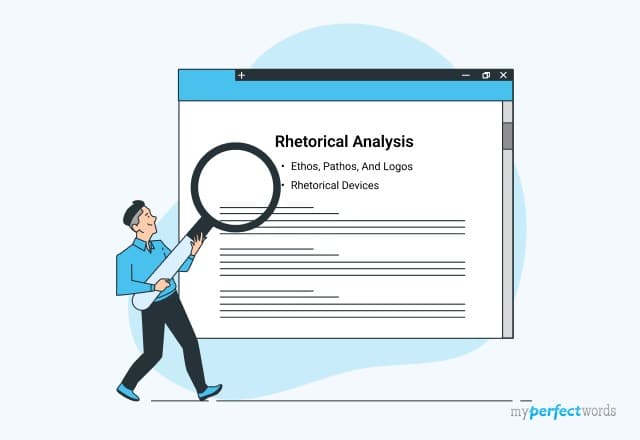
Academia.edu no longer supports Internet Explorer.
To browse Academia.edu and the wider internet faster and more securely, please take a few seconds to upgrade your browser .
Enter the email address you signed up with and we'll email you a reset link.
- We're Hiring!
- Help Center

RHETORICAL ANALYSIS SAMPLE ESSAY

Related Papers
Brooke Gizzi-Stewart
This thesis examines the art of persuasive communication in political discourse. It aims to identify and explore patterns of persuasive audience appeals and rhetorical devices in a selection of set piece election campaign speeches. The thesis provides qualitative analyses of the full transcripts of ten campaign speeches: five from the 1996 and five from 2007 Australian federal election campaigns. These include the Prime Minister’s election-calling speech, the respective Australian Labor Party and Liberal National Coalition campaign launches, and the Prime Minister’s and Opposition Leader’s respective addresses to the National Press Club at the end of the campaign. The common factor for these two elections is a change of government: from Prime Minister Paul Keating and the ALP to Opposition Leader John Howard and the Coalition in 1996, and from Prime Minister Howard to Opposition Leader Kevin Rudd and the ALP in 2007. The speech analysis adopts an Aristotelian-based methodology to identify the persuasive nature of the language used in the key campaign speeches. Aristotle’s view of rhetoric, specifically his theory on the three persuasive audience appeals – ‘logos’, ‘ethos’ and ‘pathos’ – are combined with a number of common rhetorical devices to form the speech analysis methodology for the thesis. Each speech is approached chronologically according to their respective election campaign contexts. Language and rhetorical devices pertaining to Aristotle’s three audience appeals are identified and discussed. The rhetorical devices utilised in each speech are also compiled and discussed to further demonstrate the prevalence of mechanisms of persuasion in the campaign set pieces. Effectively, the thesis proves the existence of three inherent persuasive patterns relevant to Aristotle’s rhetorical theories thereby illustrating the relevance and applicability of a 2,400 year-old theory of political communication for studying contemporary Australian political discourse.
Scott Fraley
Chia Longman
Unpublished PhD thesis, Ghent University, 2002
Angelyn Opoku
Sripriya Ramaswamy
สมศักดิ์ แก้วนุช
Jessy Joseph
Race has always been a topic that is associated with different emotions, views, and thoughts for thousands of years. Since the beginning of times, people from different racial backgrounds such as Africans have always been judged and treated based on their race or where they were born. Brent Staples was among the renowned African American writers that fought against the negative stereotyping of black men in public spaces through his article, “Black Men and Public Space” in which he employs numerous rhetorical uses that add more appeal to his descriptions of experiences as a black man in public spaces. Staples’ article is a great example of how racism despite the progress made over the years, is still present. In writing this essay, Brent Staples reveals how black men, in spite of all their qualifications and achievements in life, are still discriminated against, for simply taking a walk. The author uses many examples of how different white Americans show racial stereotyping, from law enforcement to random people walking at night, which not only reveals how some Americans can be ignorant but also how they are likely to judge a person based on their skin color without considering other aspects of their life.
Sr Geo Mx Dj
sally neouchi
placemaking
RELATED PAPERS
www.neuroaffectivecbt.com
Daniel Mirea
Physical Review E
JORGE FABIANO BERLATTO MENDEZ
H Sabetamal
Investigaciones Sociales
Jorge Elias Silva Sifuentes
Mathematical Problems in Engineering
Muhammad sulaiman
Journal of modern science
Tomasz Binek
Martha Vaughan
Physica B: Condensed Matter
KHANG NGUYỄN HOÀNG
Molecular Ecology Notes
nadia rubio
HUD文凭证书 HUD毕业证书
Sidney Cabral Lourenço
Obstetrics & Gynecology
james anasti
Ralf Deiterding
Debasish Chatterjee
Chemical engineering transactions
Yunzile Dzhelil
Journal of the American Statistical Association
Humana Press eBooks
Richard Pestell
British Journal of Anaesthesia
Victor Castro
Kotaro ICHIKAWA
Brazilian Archives of Biology and Technology
Marina Maizato
- We're Hiring!
- Help Center
- Find new research papers in:
- Health Sciences
- Earth Sciences
- Cognitive Science
- Mathematics
- Computer Science
- Academia ©2024

IMAGES
VIDEO
COMMENTS
Rhetorical Analysis Sample Essay. Harriet Clark. Ms. Rebecca Winter. CWC 101. 13 Feb. 2015. Not Quite a Clean Sweep: Rhetorical Strategies in. Grose's "Cleaning: The Final Feminist Frontier". A woman's work is never done: many American women grow up with this saying and feel it to be true. 1 One such woman, author Jessica Grose, wrote ...
Learn how to analyze a text in terms of rhetoric, such as appeals, claims, supports, and warrants. See examples of rhetorical analysis essays and tips on structure, introduction, body, and conclusion.
Like all other essays, your rhetorical analysis essay will have an introduction with a thesis, body paragraphs, and a conclusion. WRITE - write your essay. Asher AP ELAC Name: _____ Step 3: Organizing and Writing Your Essay: Some of this is redundant, but this breaks down some of the steps from MAD TO WRITE even further. ...
Rhetorical appeal #2: Pathos. The purpose of Pathos-driven rhetoric is to appeal to the reader's emotions. A common example of pathos as a rhetorical means is adverts by charities that try to make you donate money to a "good cause". To evoke the intended emotions in the reader, an author may use passionate language, tell personal stories ...
A rhetorical analysis analyzes how an author argues rather than what an author argues. It focuses on what we call the "rhetorical" features of a text—the author's situation, purpose for writing, intended audience, kinds of claims, and types of evidence—to show how the argument tries to persuade the reader. Structure.
RHETORICAL ANALYSIS SAMPLE ESSAY. 13 Feb. 2015 Not Quite a Clean Sweep: Rhetorical Strategies in Grose's "Cleaning: The Final Feminist Frontier" A woman's work is never done: many American women grow up with this saying and feel it to be true. One such woman, author Jessica Grose, wrote "Cleaning: The Final Feminist Frontier ...
Rhetorical analysis is the process of evaluating elements of a text and determining how those elements impact the success or failure of that argument. Often rhetorical analyses address written arguments, but visual, oral, or other kinds of "texts" can also be analyzed. Asking the right questions about how a text is constructed will help you ...
Name the author of the text and the title of their work followed by the date in parentheses. Use a verb to describe what the author does, e.g. "implies," "asserts," or "claims". Briefly summarize the text in your own words. Mention the persuasive techniques used by the rhetor and its effect.
Read the following sample rhetorical analysis of an article. If you like, you can read the original article the student analyzes: Why I won't buy an iPad (and think you shouldn't, either). Then, click the image below to open a PDF of the sample paper. The strategies and techniques the author used in this rhetorical analysis essay have been ...
Steps in Creating a Rhetorical Analysis Part 1: Analyze. 1. Pick your text and read it thoroughly. 2. Determine the speaker, audience, purpose, & genre. • The speaker refers to the first and last name of the writer. If the writer has credentials that lend to their authority on the subject, consider those.
Her story "The Astronaut" won the 2018 Shirley Jackson Award for short fiction and received a "Distinguished Stories" mention in the 2019 Best American Short Stories anthology. How to write the AP Lang rhetorical analysis essay. We look at a AP lang rhetorical analysis essay example and explore do's and don'ts.
RHETORICAL ANALYSIS Rhetoric studies how writers use words to influence a reader. Rhetorical analysis separates a work of non-fiction into manageable parts and then demonstrates how these parts together create a persuasive argument. When writing a rhetorical analysis you are NOT summarizing a text NOR are writing whether you agree with the ...
This article will find some examples that will help you with your rhetorical analysis essay writing effortlessly. On This Page. 1. Good Rhetorical Analysis Essay Example. 2. Rhetorical Analysis Essay Example AP Lang 2023. 3. Rhetorical Analysis Essay Examples for Students. 4.
Rhetorical Analysis Essay: Formatting Created by: Brandon Everett Summer 2019 *This is a general outline for your rhetorical analysis and can be adapted to the various prompts and guidelines provided by the instructor or professor. Introduction and Thesis Provide necessary background and context: clearly introduce the document, essay or
Rhetorical Analysis Essay: Ethos, Pathos, Logos Created by: Brandon Everett Summer 2019 An appeal is an author's attempt to earn audience approval. Authors will utilize specific devices and techniques to appeal to emotion, values, character, and reason in their writing in order to make their arguments more persuasive.
rhetorical analysis, both by your insights into your topic and by the way you write your essay. As with all academic writing, your ultimate goal is to persuade your readers that your claims about rhetoric and the text are valid and provable. We have several examples to use as models for how to write your essay: Selzer's analysis of
5. State your thesis. Now that you've completed your analysis of the material, try to summarize it into one clear, concise thesis statement that will form the foundation of your essay. Your thesis statement should summarize: 1) the argument or purpose of the speaker; 2) the methods the speaker uses; and 3) the effectiveness of those methods ...
use to brainstorm the rhetoric of the sample you are studying. How Do I Write a Rhetorical Analysis? Take the following four steps to develop content and plan your rhetorical analysis essay draft. 1. Analyze the rhetorical appeals. 2. Brainstorm your introduction. 3. Develop your body paragraphs. 4. Draw a Conclusion.
About this sample rhetorical analysis: The following rhetorical analysis originally appeared in Volume 10 of e-Vision Journal of First-Year Writing, which published the work of students in James Madison University's first-year writing courses from 2000-2012. This paper analyzes an opinion piece that was
Download Free PDF. View PDF. RHETORICAL ANALYSIS SAMPLE ESSAY Harriet Clark Ms. Rebecca Winter CWC 101 13 Feb. 2015 Not Quite a Clean Sweep: Rhetorical Strategies in Grose's "Cleaning: The Final Feminist Frontier" A woman's work is never done: many American women grow up with this saying and feel it to be true.
Paper #1 - Rhetorical Analysis Draft Due via CTools (in your drop box) by 10:00 a.m. on Monday, Sept. 29 Bring two hard copies of your draft to class Write an essay (3 pages) in which you analyze and evaluate the rhetorical strategies employed by Lewis Thomas, Randy Moore, or Barbara Sharf. What was the author's
A rhetorical analysis is writing about how the author makes his/her argument and whether or not their method used is successful. Prewriting Questions Author ... Each paragraph should give examples of rhetorical techniques the author uses while giving examples from the text. Make sure to end each body paragraph with a transition sentence that
Gandhi balances fear of losing a resource and thoughts of gaining an ally. AP English Language and Composition Question 2: Rhetorical Analysis (2019) Sample Student Responses. 7. in his letter. Fear of one and hope for another, better, relationship was Gandhi's goal to convince Lord Irwin to end the Salt Law.